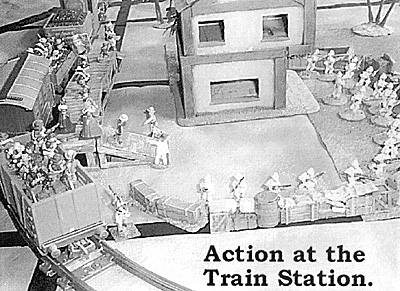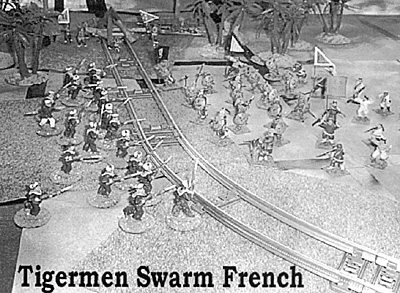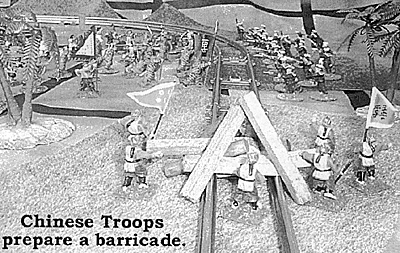
The game as played
The assigned starting places for each group is designed to bring some confusion to the beginning of the game. This tended to duplicate the real situation. Additionally the players took several turns to not only talk with each other but also to really comprehend how to win the game by understanding their mission and how to fulfill it with minimum casualties. As usual most players just want to get in and bash someone.
In some skirmish games the game master draws a card for movement and a red card moves one side and a black card another side. Usually one side will pick a unit and let it move. This mandates teamwork and central coordination of team moves because each team will try to decide which unit is in the most trouble or which unit move will be most advantageous. You want to prevent this. I prepared a unit card for each unit, which was drawn and then shuffled each turn. This causes the game to be played by a collection of individual units rather than as an integrated chain of command.
Phase One: Allies to the Rescue
Since most of the action revolves around the train, this report will begin by focusing on the happenings at the train station and then discuss the results of actually getting the train moving. The game opened with the allied players just trying to untangle their forces. The French wanted out and marched straight out of town alon" the Railroad track. They crossed the line of march of both the United States and British Troops. Their lack of cooperation was obvious and ultimately costly. The Americans immediately mixed up their troops and missions getting into position. Some of the Buffalo soldiers went with the Marines who went to help the British instead of focusing on their mission of gathering up civilians and getting them loaded onto the trains.
The British player made straight for the hastily prepared positions to the rear of the train station. Since their starting location was in a congested area they had to "short move" to get into position. However once they occupied their defensive works these hasty barricades would serve them well in defending against repeated Boxer attacks. In the Sword and the Flame rules it is a very slow process to climb over walls especially when defended.
The headstrong French forced their way through other friendly formations tangling up their allies. Once exiting the general train station area they were clearly on their own. This would not go unnoticed for long. Back at the station the civilians milled around without direction. Since there was no mission given to them, or turn card in the deck assigned to this group, the U.S. forces had to get to them and start issuing orders for them to board the trains. In essence they had to wait to be rescued. It would take three turns to straighten things out enough to actually get down to the rescue business.
All the Chinese units were drawn to train station like a magnet. After action maps clearly indicated that these units were responding to the train infrastructure and troop concentrations, rather than focusing on their individual mission. Neither were they figuring out creative ways to accomplish their missions and reduce casualties. It would take a good bloody nose to provide the motivation.
Phase Two: Action at the Station
As the US troops realized the imperative of loading troops and civilians they began to que up non-essential troops and civilians into boarding lines. They had sent some units to assist the British, who were not expecting help. This action had the effect of diluting the strength of the American units. The American commander wisely loaded and crewed his Colt Machine guns onto the flat cars first. This created mobile pillboxes that were used with telling effect throughout the remainder of the game.
The British remained hotly engaged protecting the exterior lines of the train yard. Essentially they were doing the bulk of the fighting. Casualties began to mount however their morale held Meanwhile the French were making haste down the out of town train tracks. They remained unmolested for several turns.
The commander of the Imperial troops grew an immense set of testicles and set up the artillery and began bombardment, Line of Sight problems resulted in a set up too close to allied rifle fire that proved deadly to Chinese artillery crews. The Chinese dilernma of firing on either the train cars, train station or on personnel reduced artillery effectiveness. The Chinese artillery was eliminated as their crew size fell below the necessary two-man Crew requirement. Chinese rifle fire proved ineffective against men in rail flat cars and by now firing from the windows of passenger cars.
Repeated boxer charges were repulsed across the board. Casualties began to mount, which was noticed by the Imperial Troop commander and the player managing the Tiger Men, Follow on Imperial Troops and the Tiger Men began to shift their attention to easier targets, like the French, and railroad equipment
Phase Three: The Escape Begins
As the Chinese realized that direct charges would not succeed the Boxers begin working around the British flanks, This caused the firing line to thin and reduced the British firepower. Even with the added firepower from, American troops on the train, British casualties increased and morale checks became more frequent. Ultimately they failed a morale roll, possibly none too soon. They had done their job, which allowed the train to begin its slow start out of the station.
By now all the civilians, wounded and combat effective Buffalo Soldiers and Marines were loaded and moving. Since the train rules allowed for a slow moving train to accept last minute boarders, some straggling troopers jumped on as the train began its life saving crawl out of the station. Realizing that discretion is sometimes the better part of valor, the remaining British troops exited the board just ahead of the now swarming Boxers.
By now the remaining Boxer troops (unit E2), have clearly re-thought their mission and begin to move the wagon load of barricade material to a remote track site to block the train tracks. As the train has now left the station it would be difficult to intercept the train there. The Chinese realized that only a spot on the far side of the table was within reach. A foot race now began between the Chinese troops and the train that was rapidly picking up speed.
Phase Four: The Trap is Sprung
All the serious action now moved to the far end of the table. By now the French had begun to reach the table edge and hoped to effect an escape. If only the movement die rolls had been more kind. The Tiger Men moved rapidly diagonally across the board and were within charge distance and preparing to strike. Tiger Men were specialists in the Chinese Army. They were half gymnast, half infantry. Their tumbling and jumping skills were specialized to take down mounted troops. This was the purpose of the three-pointed grappling hook you often see in drawings of them. Essentially they were close combat troops. The French would now have a first hand experience with them.
 To prevent a rear attack the French would now have to deviate from their straightforward plan to escape Since the best defense is a good offense the French announced a charge first and attempted to wade into the Tiger Men. The French hoped the Tiger Men would fail their "Stand to a Charge roll" and bounce back. This would allow them to continue to escape. No such luck and the melee was on. What ensued was a large two-turn melee. This occurred with the train picking up speed, moving down the track right into the melee.
To prevent a rear attack the French would now have to deviate from their straightforward plan to escape Since the best defense is a good offense the French announced a charge first and attempted to wade into the Tiger Men. The French hoped the Tiger Men would fail their "Stand to a Charge roll" and bounce back. This would allow them to continue to escape. No such luck and the melee was on. What ensued was a large two-turn melee. This occurred with the train picking up speed, moving down the track right into the melee.
Just about the time the melee was resolving itself in the Tiger Men's favor a small group of boxers decided they wanted to jump aboard the train and close assault the train engineer This was not foreseen in the basic game design and called for creative problem solving by the game master. A decision was made and agreed to by all parties that a roll of a six on a d6 would allow the attacker to board the train. A one through five would result in fatal injury. Four out of five Boxers jumped to their death. The last surviving Boxer went for the engineer. The resulting one on one melee in the engine compartment was one of the most exciting duels of the day. The next time the allies will put a guard in the cab. Anyway the engineer won and the train hurtled on picking up speed and headed for daylight.
As the train passed the remaining French soldiers the Americans and the liberated civilians waved to their retreating allies. Although the French has struck out on their own their action succeeded in tying down many Chinese troops and allowed the escaping train to finish the second leg of their journey to freedom. However the French like their British companions were finished for the game.
All that remained was for the train to race the final section of track to the table edge, to freedom. All that remained in their way was a breakaway group of Boxers (marked E2 on the map). By about turn four they had realized that the winning strategy was to haul the load of barricades over to a remote section of track and pile up enough debris to derail the train, The destruction and/or capture of European could be accomplished at their leisure. Although not as glorious a task as assaulting entrenched troops, this engineer job could be a battle winner.
 By the time the train reached the barricade they had survived the Empress's artillery, shot their way past the screaming Boxers and Imperial Rifles. The freedom train was rolling to safety. Or so it seemed. At the far end of the table the Chinese has constructed quite an impressive barricade of logs and railroad ties. The immovable object was about to meet the irresistible force. Chinese cleverness was about to be confronted with the brute force of Western technology, At the point of impact the nine points of piled wood was overcome by the 10-point combination of train and speed. To the sound of screeching train wheels, shattered wood and a shower of splinters the Americans escaped with their charges.
By the time the train reached the barricade they had survived the Empress's artillery, shot their way past the screaming Boxers and Imperial Rifles. The freedom train was rolling to safety. Or so it seemed. At the far end of the table the Chinese has constructed quite an impressive barricade of logs and railroad ties. The immovable object was about to meet the irresistible force. Chinese cleverness was about to be confronted with the brute force of Western technology, At the point of impact the nine points of piled wood was overcome by the 10-point combination of train and speed. To the sound of screeching train wheels, shattered wood and a shower of splinters the Americans escaped with their charges.
Game Summary
Every now and then you play a game that just turns out right. It has the proper balance of fun and excitement. This was one of those games. In some games there just never seems to be a clear winner, you just slug it out all around the board all afternoon and end in a stalemate. In this game, after all the skirmishing, all the maneuvering it didn't even require a dice roll or a judges call to determine the winning player. It was obvious the prize got away.
In retrospect the scenario lent itself well to The Sword and the Flame rules. The only modification might have been to mix up Boxers with pole arms, swords and rifles among the three groups rather than leave them in like-armed units. Additionally the addition of the "Jumping on the Train" rule allowed a clever tactic to be tried. I always like to accommodate as much as possible as long as everyone agrees the rule decision is fair. This game will be played again at the upcoming September Hurricon convention in Tampa.
Last Train From Yang Tsun A Boxer Rebellion Scenario For The Sword and The Flame
Back to MWAN #119 Table of Contents
Back to MWAN List of Issues
Back to MagWeb Magazine List
© Copyright 2002 Hal Thinglum
This article appears in MagWeb (Magazine Web) on the Internet World Wide Web.
Other military history articles and gaming articles are available at http://www.magweb.com